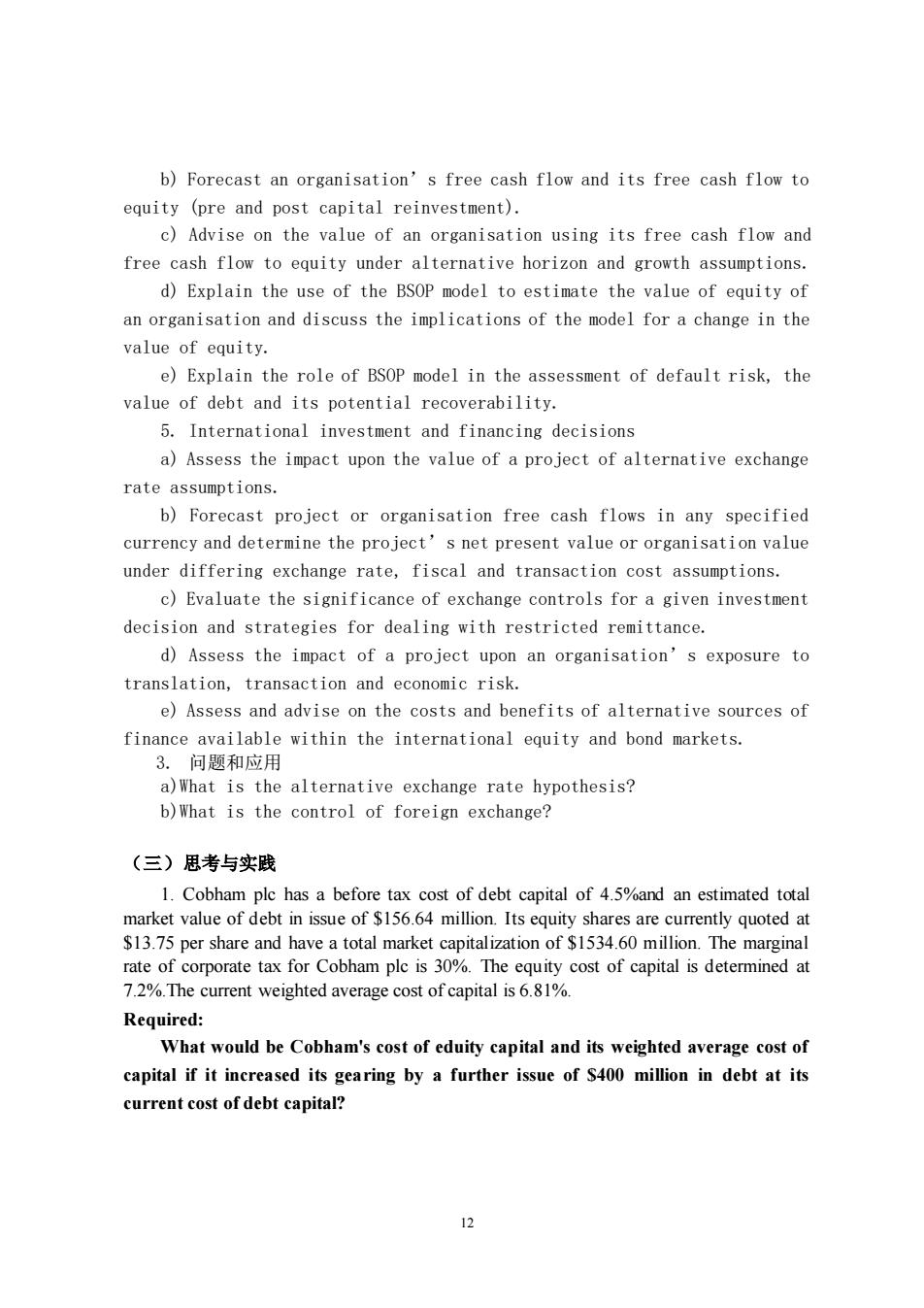正在加载图片...

b)Forecast an organisation's free cash flow and its free cash flow to equity (pre and post capital reinvestment) c)Advise on the value of an organisation using its free cash flow and free cash flow to equity under alternative horizon and growth assumptions. d)Explain the use of the BSOP model to estimate the value of equity of an organisation and discuss the implications of the model for a change in the value of eguity. e)Explain the role of BSOP model in the assessment of default risk,the value of debt and its potential recoverability. 5.International investment and financing decisions a)Assess the impact upon the value of a project of alternative exchange rate assumptions. b)Forecast project or organisation free cash flows in any specified currency and determine the project's net present value or organisation value under differing exchange rate,fiscal and transaction cost assumptions. c)Evaluate the significance of exchange controls for a given investment decision and strategies for dealing with restricted remittance. d)Assess the impact of a project upon an organisation's exposure to ranslation,transaction and economic risk. e)Assess and advise on the costs and benefits of alternative sources of inancwithin the international cquity and bond markets a)What is the alternative exchange rate hypothesis? b)What is the control of foreign exchange? (三)思考与实践 1.Cobham ple has a befor tax cost of debt capital of 4.5%and an estimated total market value of debt in issue of $156.64 million.Its equity shares are currently quoted at $13.75 per share and have a total market capitalization of $1534.60 million.The marginal rate of corporate tax for Cobham ple is 30%.The equity cost of capital is determined at 7.2%.The current weighted average cost of capital is 6.81%. Required: What would be Cobham's cost of eduity capital and its weighted average cost of capital if it increased its gearing by a further issue of $400 million in debt at its current cost of debt capital? 12 12 b) Forecast an organisation’s free cash flow and its free cash flow to equity (pre and post capital reinvestment). c) Advise on the value of an organisation using its free cash flow and free cash flow to equity under alternative horizon and growth assumptions. d) Explain the use of the BSOP model to estimate the value of equity of an organisation and discuss the implications of the model for a change in the value of equity. e) Explain the role of BSOP model in the assessment of default risk, the value of debt and its potential recoverability. 5. International investment and financing decisions a) Assess the impact upon the value of a project of alternative exchange rate assumptions. b) Forecast project or organisation free cash flows in any specified currency and determine the project’s net present value or organisation value under differing exchange rate, fiscal and transaction cost assumptions. c) Evaluate the significance of exchange controls for a given investment decision and strategies for dealing with restricted remittance. d) Assess the impact of a project upon an organisation’s exposure to translation, transaction and economic risk. e) Assess and advise on the costs and benefits of alternative sources of finance available within the international equity and bond markets. 3. 问题和应用 a)What is the alternative exchange rate hypothesis? b)What is the control of foreign exchange? (三)思考与实践 1. Cobham plc has a before tax cost of debt capital of 4.5%and an estimated total market value of debt in issue of $156.64 million. Its equity shares are currently quoted at $13.75 per share and have a total market capitalization of $1534.60 million. The marginal rate of corporate tax for Cobham plc is 30%. The equity cost of capital is determined at 7.2%.The current weighted average cost of capital is 6.81%. Required: What would be Cobham's cost of eduity capital and its weighted average cost of capital if it increased its gearing by a further issue of $400 million in debt at its current cost of debt capital?